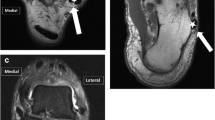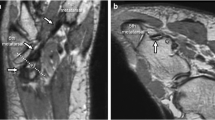Abstract
Purpose
Flexor hallucis longus (FHL) and flexor digitorum longus (FDL) tendons are frequently used in surgery. Therefore, it is necessary to evaluate the chiasma plantare formation preoperatively. The development of ultrasonography (US) may help the chiasma plantare formation evaluation. The purpose of this study is to prove the usefulness of the US method using cadavers.
Methods
Eleven cases (twenty-two ankles) were obtained from Asian adult cadavers. At first, we evaluated and compared the chiasma plantare formation using US. Later, we evaluated that using the findings after dissection as type A (connection from FHL to FDL of the second toe), type B (connection from FHL to the second and third toes), type C (connection from FHL to the second through fourth toes), or type D (connection from FHL to all lesser toes).
Results
Chiasma plantare formation was classified as types A and B in fifteen and seven ankles, respectively. After dissection, chiasma plantare formation was classified as types A, B, and C in fourteen, six, and two ankles, respectively. Therefore, there was an 86% similarity between the two methods.
Conclusions
Chiasma plantare formation can be reliably and noninvasively evaluated using US. This may be useful for preoperative rehabilitation or surgical procedure planning.



Similar content being viewed by others
Availability of data and materials
The datasets generated during and/or analyzed during the current study are available from the corresponding author on reasonable request.
References
Amlang M, Rosenow MC, Friedrich A, Zwipp H, Rammelt S (2010) Direct plantar approach to Henry’s knot for flexor hallucis longus transfer. Foot Ankle Int 33(1):7–13. https://doi.org/10.3113/FAI.2012.0007
Edama M, Kubo M, Onishi H, Takabayashi T, Yokoyama E, Inai T, Watanabe H, Nashimoto S, Kageyama I (2016) Anatomical study of toe flexion by flexor hallucis longus. Ann Anat 204:80–85. https://doi.org/10.1016/j.aanat.2015.11.008
Guyton GP, Jeng C, Krieger LE, Mann RA (2001) Flexor digitorum longus transfer and medial displacement calcaneal osteotomy for posterior tibial tendon dysfunction: a middle-term clinical follow-up. Foot Ankle Int 22:627–632. https://doi.org/10.1177/107110070102200802
Hicks JH (1954) The mechanics of the foot. II. The plantar aponeurosis and the arch. J Anat 88(1):25–30
Kelly LA, Cresswell AG, Racinais S, Whiteley R, Lichtwark G (2014) Intrinsic foot muscles have the capacity to control deformation of the longitudinal arch. J R Soc Interface. https://doi.org/10.1098/rsif.2013.1188
LaRue BG, Anctil EP (2006) Distal anatomical relationship of the flexor hallucis longus and flexor digitorum longus tendons. Foot Ankle Int 27:528–532. https://doi.org/10.1177/107110070602700708
Mao H, Shi Z, Wapner KL, Dong W, Yin W, Xu D (2015) Anatomical study for flexor hallucis longus tendon transfer in treatment of Achilles tendinopathy. Surg Radiol Anat 37:639–647. https://doi.org/10.1007/s00276-014-1399-y
Menz HB, Morris ME, Lord SR (2005) Foot and ankle characteristics associated with impaired balance and functional ability in older people. J Gerontol A Biol Sci Med Sci 60:1546–1552. https://doi.org/10.1093/gerona/60.12.1546
Mulier T, Rummens E, Dereymaeker G (2007) Risk of neurovascular injuries in flexor hallucis longus tendon transfers: an anatomic cadaver study. Foot Ankle Int 28:910–915. https://doi.org/10.3113/FAI.2007.0910
Murphy RL, Womack JW, Anderson T (2010) Technique tip: a new technique for harvest of the flexor hallucis longus tendon. Foot Ankle Int 31:457–459. https://doi.org/10.3113/FAI.2010.0457
O’Sullivan E, Carare-Nnadi R, Greenslade J, Bowyer G (2005) Clinical significance of variations in the interconnections between flexor digitorum longus and flexor hallucis longus in the region of the knot of Henry. Clin Anat 18:121–125. https://doi.org/10.1002/ca.20029
Plaass C, Abuharbid G, Waizy H, Ochs M, Stukenborg-Colsman C, Schmiedl A (2013) Anatomical variations of the flexor hallucis longus and flexor digitorum longus in the chiasma plantare. Foot Ankle Int 34:1580–1587. https://doi.org/10.1177/1071100713494780
Saeki J, Ikezoe T, Nakamura M, Nishishita S, Noriaki I (2017) The reliability of shear elastic modulus measurement of the ankle plantar flexion muscles is higher at dorsiflexed position of the ankle. J Foot Ankle Res 10:18. https://doi.org/10.1186/s13047-017-0199-0
Uritani D, Fukumoto T, Matsumoto D, Shima M (2014) Reference values for toe grip strength among adults aged 20 to 79 years: a cross-sectional study. J Foot Ankle Res 7:28. https://doi.org/10.1186/1757-1146-7-28
Uritani D, Fukumoto T, Matsumoto D, Shima M (2015) Association between toe grip strength and hallux valgus, toe curl ability, and foot arch height in Japanese adults aged 20 to 79 years: a cross-sectional study. J Foot Ankle Res 8:18. https://doi.org/10.1186/s13047-015-0076-7
Acknowledgements
The authors would like to acknowledge and thank those anonymous individuals who generously donated their bodies so that this study could be performed.
Funding
None.
Author information
Authors and Affiliations
Contributions
DB and HK contributed to study design and data collection, and drafted the manuscript; SM and TM contributed to data analysis and made critical revisions to the manuscript; PM made critical revisions to the manuscript; YT supervised the study, contributed to analysis and interpretation of data, and made critical revisions to the manuscript. All authors read and approved the final manuscript prior to submission.
Corresponding author
Ethics declarations
Conflict of interest
The authors declare that they have no conflict of interest.
Ethical approval
The methods were carried out in accordance with the 1964 Declaration of Helsinki. And this anatomical study was approved by the ethics committee of our department (ANA-2562-06064).
Additional information
Publisher's Note
Springer Nature remains neutral with regard to jurisdictional claims in published maps and institutional affiliations.
Rights and permissions
About this article
Cite this article
Bai, D., Kurokawa, H., Morita, S. et al. Ultrasonographic test for detecting the chiasma plantare formation between the flexor hallucis longus and flexor digitorum longus. Surg Radiol Anat 43, 1061–1065 (2021). https://doi.org/10.1007/s00276-020-02630-4
Received:
Accepted:
Published:
Issue Date:
DOI: https://doi.org/10.1007/s00276-020-02630-4




